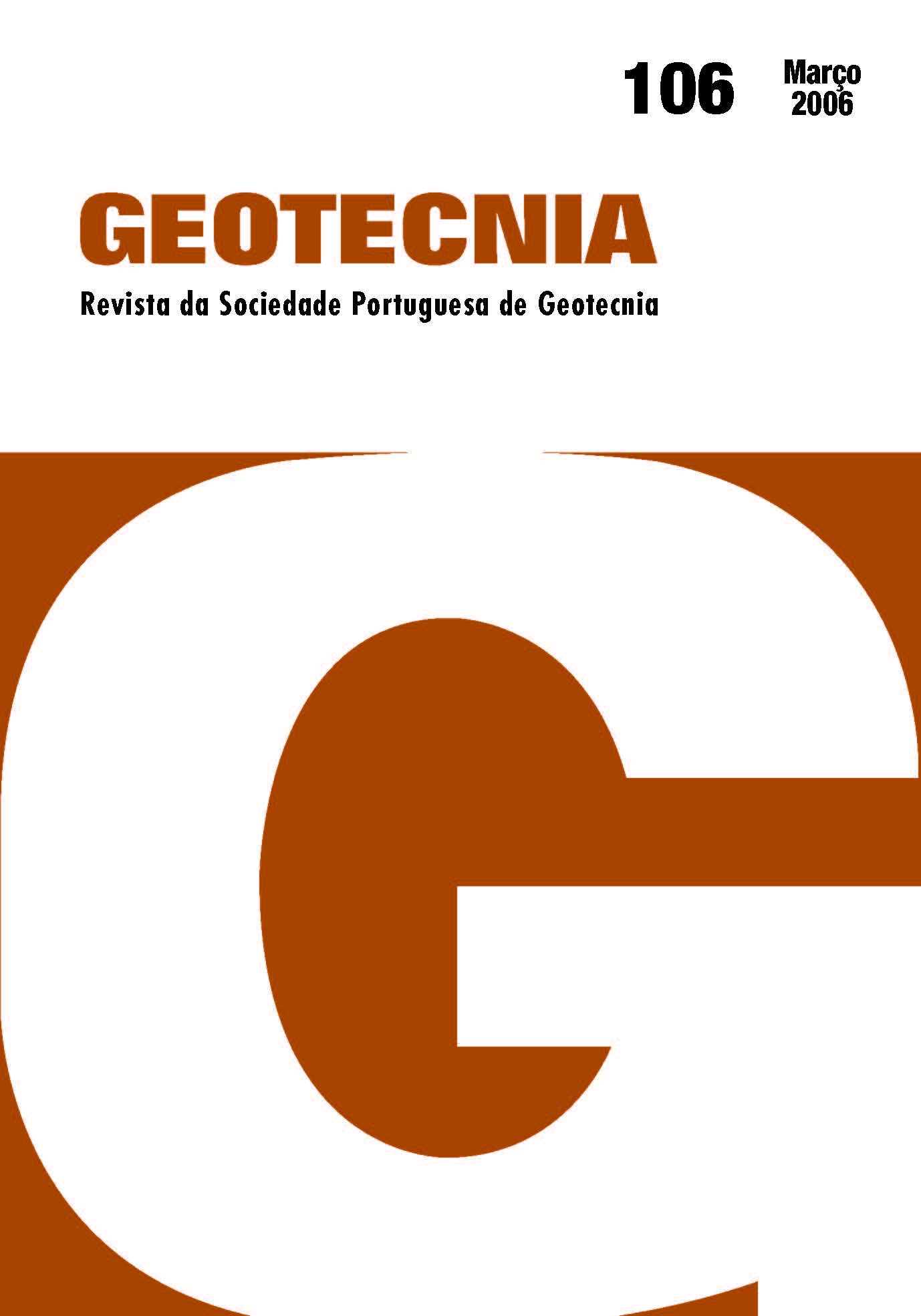Análise dos métodos de controlo de integridade de geomembranas de PEAD usadas em aterros de RSU
DOI:
https://doi.org/10.14195/2184-8394_106_6Resumo
Nos aterros de resíduos sólidos urbanos (RSU), as geomembranas são utilizadas no sistema de confinamento da base e taludes, como barreira à fuga de lixiviados, devendo resistir a agressões químicas e biológicas por parte dos resíduos, lixiviados e biogás, a agressões mecânicas durante a construção (tráfego de obra, colocação de camadas sobrejacentes, etc.) e exploração (peso dos resíduos, assentamentos da fundação, etc.) e ao efeito da exposição aos raios solares, entre outros. Como a eficácia do funcionamento do sistema de confinamento dos aterros de RSU está muito dependente do desempenho das geomembranas e este da sua integridade física, considerou-se importante apresentar os possíveis tipos e origens dos danos a que as geo membranas podem ser sujeitas e fazer uma análise dos métodos mais adequados para a detecção de orifícios e subsequente reparação.
Downloads
Referências
ASTM D 4437 (1999) – “Standard practice for determining the integrity of field seams used in joining flexible polymeric sheet geomembranes”, American Society of Testing Materials, USA.
ASTM D 6392 (1999) – “Standard test method for determining the integrity of nonreinforced geomembrane seams produced using thermo-fusion methods”, American Society of Testing Materials, USA.
ASTM D 6747 (2002) – “Standard guide for selection of techniques for electrical detection of potential leak paths in geomembranes”, American Society of Testing Materials, USA.
Bouzza A., Zornberg J. G., Adam D. (2002) – “Geosynthetics in waste containment facilities: recent advances”, 7th International Conference on Geosynthetics, Nice, France, 21 to 23 September, pp 445-507.
CFGG, (2003) – “Présentation de méthodes de détection et de localisation de défauts dans les dispositifs d’étanchéité par géomembranes”, Comité Français Géosynthétiques, France.
David E. Daniel, Robert M. Koerner, (1995) – “Waste containment facilities. Guidance for construction, quality assurance and quality control of liner and cover systems”, American Society of Civil Engineering Press, New York.
GRI GM14 (1998) – “Standard Guide for Selecting Variable Intervals for Taking Geomembrane Destructive Seam Samples Using the Method of Attributes”, Geosynthetic Research Institute, Drexel University, USA.
GRI GM19 (2002) – “Standard Specification for Seam Strength and Related Properties of Thermally Bonded Polyolefin Geomembranes”, Geosynthetic Research Institute, Drexel University, USA. (Revista em 2003).
GRI GM20 (2002) – “Standard Guide for Selecting Variable Intervals for Taking Geomembrane Destructive Seam Samples Using control Charts”, Geosynthetic Research Institute, Drexel University, USA.
Haxo H., Kamp L. (1990) – “Destructive Testing of Geomembranes Seams: Shear and Peel Testing of Seam Strength”, Geotextiles and Geomembranes nº 9, pp 369-404.
Koerner R. M. (1998) – “Designing with Geosynthetics”, Fourth Edition. Prentice Hall, Upper Saddle River, New Jersey.
McQuade S. J., Needham A.D (1999) – “Geomembrane liner defects-causes, frequency and avoidance”, Geotechnical Engineering nº 137 pp 203-213.
Nosko V., Andrezal T., Gregor T., Ganier, P. (1996) – “SENSOR damage detection system (DDS)- the unique geomembrane testing method”. Proceedings of 1st European Geosynthetics Conference, Maastricht, pp 743-748.
Nosko V., Touze-Foltz N. (2000) – “Geomembrane liner failure:modelling of its influence on contaminant transfert”. Proceedings of 2nd European Geosynthetics Conference, Bologna, vol 2, pp 557-560.
Phaneuf R., Peggs I. D. (2001) – “Landfill construction quality, lessons learned from electrical resistivity testing of geomembrane liners”. Geotechnical Fabrics Report, April 2001, pp 28-35.
Peggs I. D., Little D. (1985) – “The Effectiveness of peel and shear tests in evaluating HPDE geomembrane seams”, 2nd Canadian Symposium on Geotextiles and Geomembranes, pp 141-146.
Peggs I. D. (1990) – “Destructive Testing of Polyethylene Geomembrane Seams: Various Methods to Evaluate Seams Strength”, Geotextiles and Geomembranes nº9 (4), pp 405-414.
Robert M. Koerner, Arthur E. Lord Jr (1990) – “Nondestructive evaluation of geomembrane seams: methods in development”, Geotextiles and Geomembranes nº 9 (4) pp 431-443.
Rowe, R. K. (1998) – “Geosynthetics and the minimization of contaminant migration through barrier systems beneath solid waste”, Proceedings of 6th International Conference on Geosynthetics, Atlanta, vol. 1, pp 27-102.
Steel Dragon Enterprise CO, Ltd (2001) – “Quality Assurance Manual for the installation of flexible membrane lining systems”. Publicação editada na página da empresa Steel Dragon Enterprise CO, Ltd e consultada em 9 de Novembro de 2001.
Timothy D. Stark, John Heap, Stuart Lange, Dave Mc Laury, Standford Slifer (2005) – “Air – chanel testing landfill geomembrane seams. Results from a recent workshop help minimize destructive testing”, GFR magazine, Geosynthetics Material Association, volume 23, nº 2, 4 pp.




